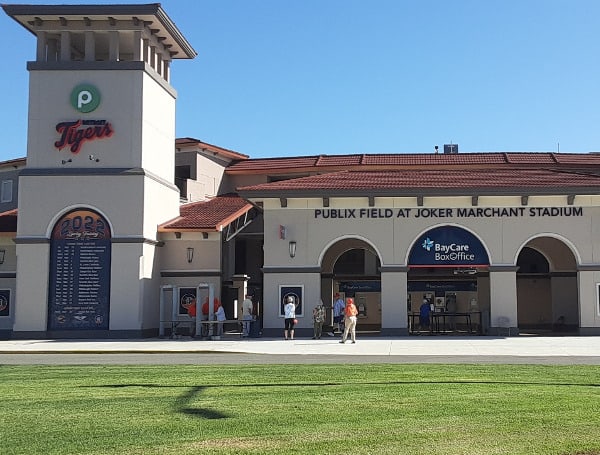Publix Field At Joker Marchant Stadium, Lakeland, Florida (Credit: Tom Layberger) Fewer fans during the COVID-19 pandemic resulted in a drop in ec
Fewer fans during the COVID-19 pandemic resulted in a drop in economic returns on state programs that provide sports-related grants and incentives, according to a newly released state analysis.
The Florida Sports Foundation claimed a small positive return for each $1 spent on grants to professional and amateur events, the analysis by the Legislature’s Office of Economic & Demographic Research found.
But with many games held without fans or with limited crowds because of pandemic restrictions, larger incentives tied to publicly funded stadiums and arenas posted negative returns.
Read: Poll: Florida Abortion Measure Falling Short Of Needed Support To Pass
“These programs are designed to bring events to Florida, thus attracting out-of-state tourists,” the analysis posted online Friday said. “Hence, the restricted attendance negatively influenced the effectiveness of the programs.”
The analysis looked at the 2019-2020, 2020-2021 and 2021-2022 fiscal years. The pandemic hit in early 2020, temporarily causing large decreases in tourism.
In the report, analysts sought to measure the economic benefit, or return on investment, for money tied to the sports foundation.
The non-profit foundation, in part, provides grants to support sports events that bring visitors to Florida. The foundation was housed in the past in the former Enterprise Florida but now is a direct-service organization within the state Department of Commerce.
The analysis found that the return on investment for the organization’s grant programs during the three fiscal years under review was $1.21 for every $1 spent, down from $4.27 in the prior three years.
Professional sports incentives had a loss of 80 cents for each $1 spent over the three-year period ending in fiscal year 2021-2022, after posting a positive return of 75 cents in the three prior years. Meanwhile, spring training incentives had a loss of 90 cents for each $1 spent, after bringing a return of 54 cents for each $1 during the three prior years.
Read: Dave Wills’ Family Grateful He’s In The Tampa Bay Rays Hall Of Fame
The grant program focuses on sporting events, professional and amateur, while the professional sports incentives are linked to stadium construction. Facilities used for regular season games by eight professional teams each draw up to $2 million a year in sales-tax dollars from the state for construction-related costs, while seven Major League Baseball spring-training sites each receive $500,000 a year in sales-tax money for construction, reconstruction and renovations.
The grant program involves far less money.
The foundation distributed grants to 361 sporting events during the three-year period, averaging $21,527. The analysis estimated the grants resulted in 502,263 out-of-state visitors that accounted for 2.495 million hotel nights.
“Participatory sporting events have less of a discretionary element than events that are primarily designed for the spectator’s entertainment value — this feature, to a degree, buffered the program from some of the worst effects from the COVID health crisis,” the analysis said.
Still, the number of out-of-state visitors to state-backed athletic events was a 23 percent drop from the prior three-year period.
Read: Bucs Owner Joel Glazer & Rock’s Behind the Scenes at the NFL Meeting in Orlando & Rays Opening Day
The professional stadium incentive figures, which included attendance at college-football bowl games and basketball tournaments, were linked to 465,745 out-of-state visitors, 22.2 percent lower than when an analysis was conducted in 2021 of prior years.
With the funding approved in 30-year deals, the eight stadiums drawing up to $2 million a year in sales-tax dollars are Hard Rock Stadium in Miami-Dade County, EverBank Stadium in Jacksonville, Tropicana Field in St. Petersburg, Amalie Arena in Tampa, Amerant Bank Arena in Broward County, Raymond James Stadium in Tampa, Kaseya Center in Miami and the Kia Center in Orlando.
Payments to all but the Kia Center are slated to be completed by 2028. The Kia Center deal stretches to 2038.
Spring-training games during the three-year review period resulted in about 166,008 out-of-state visitors linked to the state money, about 50 percent fewer than in the prior period.
Based on data over the past decade, the new analysis projected the grant program should have an annual return of $4.30 for each $1 spent, while the professional stadium incentives should have a positive return of 75 cents and the spring training sites should have a positive return of 54 cents.
Help support the Tampa Free Press by making any small donation by clicking here.
Android Users, Click To Download The Tampa Free Press App And Never Miss A Story. Follow Us On Facebook and Twitter. Sign up for our free newsletter.

